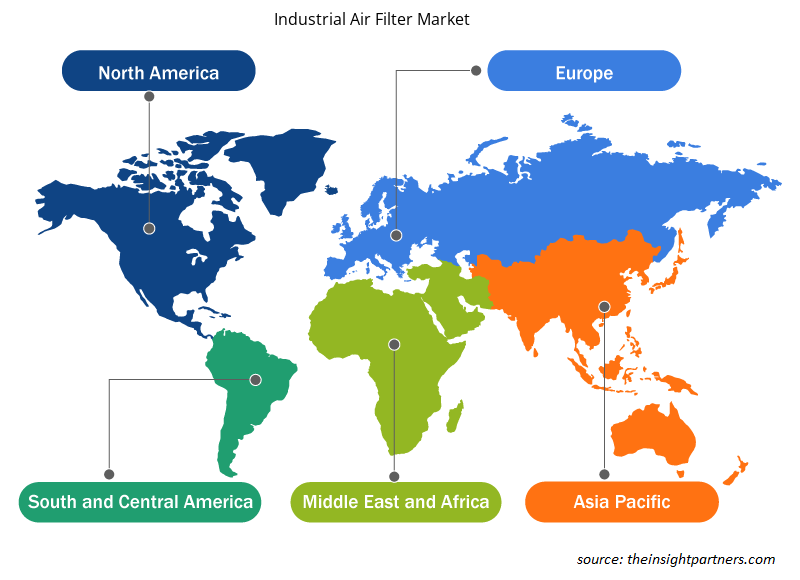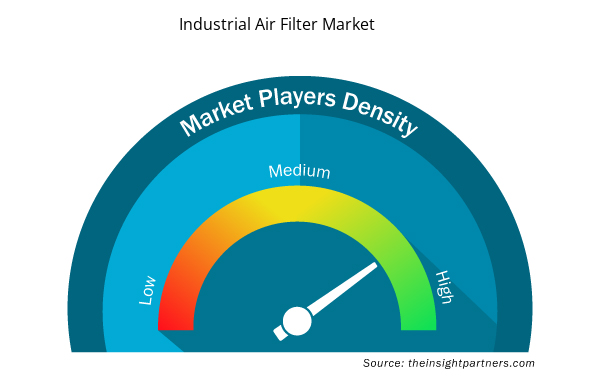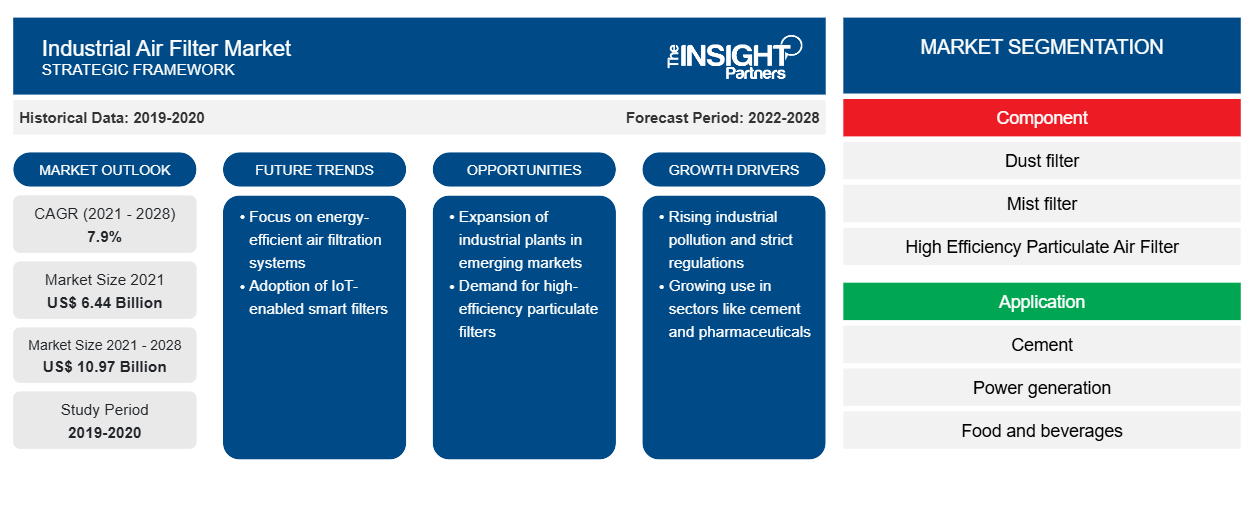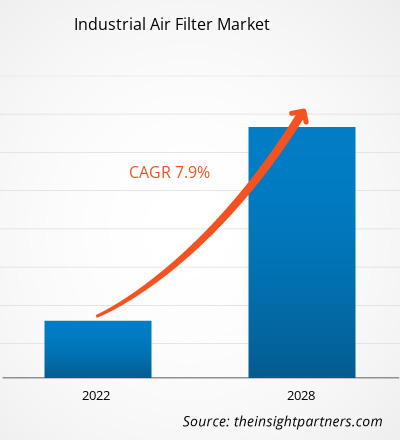[تقرير بحثي] من المتوقع أن ينمو سوق مرشح الهواء الصناعي من 6.44 مليار دولار أمريكي في عام 2021 إلى 10.97 مليار دولار أمريكي بحلول عام 2028؛ ومن المتوقع أن ينمو بمعدل نمو سنوي مركب قدره 7.9٪ خلال الفترة 2021-2028.
وجهة نظر المحلل:
لقد شهد سوق مرشحات الهواء الصناعية نموًا كبيرًا وتوسعًا في السنوات الأخيرة. ويمكن أن يعزى ذلك إلى عدة عوامل رئيسية تدفع الطلب على أنظمة ترشيح الهواء في البيئات الصناعية. أحد العوامل الرئيسية هو الوتيرة السريعة للتصنيع عبر مختلف القطاعات في جميع أنحاء العالم. مع توسع الصناعات وتكثيف عمليات الإنتاج، تزداد الملوثات والمواد الملوثة المحمولة جوًا. وهذا يستلزم تنفيذ أنظمة ترشيح هواء فعالة للحفاظ على جودة الهواء المثلى وحماية صحة العمال. عامل مهم آخر يساهم في نمو السوق هو تشديد معايير ولوائح جودة الهواء لدى الهيئات الحكومية والبيئية. تهدف هذه اللوائح إلى تقليل الانبعاثات والملوثات المنبعثة في الغلاف الجوي من العمليات الصناعية. ونتيجة لذلك، تضطر الصناعات إلى الاستثمار في تقنيات ترشيح الهواء المتقدمة للامتثال لهذه المعايير الصارمة.
علاوة على ذلك، هناك وعي متزايد بين أصحاب المصلحة الصناعيين حول التأثيرات الضارة لجودة الهواء الرديئة على الإنتاجية ورفاهية العمال والكفاءة التشغيلية الشاملة. تلعب مرشحات الهواء الصناعية دورًا حاسمًا في إزالة الجزيئات الضارة من الهواء، مثل الغبار والدخان والمواد الكيميائية ومسببات الحساسية، مما يخلق بيئة عمل أكثر صحة وأمانًا. يشمل سوق مرشحات الهواء الصناعية منتجات مختلفة تلبي قطاعات صناعية متنوعة، بما في ذلك التصنيع والسيارات والأدوية وتجهيز الأغذية والمصانع الكيميائية والإلكترونيات. تختلف هذه المرشحات في الحجم والكفاءة والتكنولوجيا، اعتمادًا على المتطلبات المحددة لكل صناعة.
نظرة عامة على السوق:
لتحسين جودة الهواء الداخلي والخارجي، تعمل مرشحات الهواء على تقليل أو إزالة الشوائب من الهواء. يحتاج أي نظام تدفئة وتهوية وتكييف هواء إلى مرشحات هواء صناعية لإزالة الجزيئات الغريبة من الهواء. تعتبر مرشحات الهواء الصناعية ضرورية في أي عمل تجاري حيث تنتج العمليات الدخان والملوثات. تحافظ هذه المرشحات على جودة الهواء الداخلي (IAQ) في البيئات المغلقة عن طريق تصفية الملوثات مثل حبوب اللقاح والغبار والملوثات الكيميائية. تمنع مرشحات الهواء الصناعية أيضًا الملوثات من دخول الآلات الصناعية ، مما يقلل من خطر تلف الآلات بسبب الجزيئات الغريبة الكبيرة.
قم بتخصيص هذا التقرير ليناسب متطلباتك
ستحصل على تخصيص لأي تقرير - مجانًا - بما في ذلك أجزاء من هذا التقرير، أو تحليل على مستوى الدولة، وحزمة بيانات Excel، بالإضافة إلى الاستفادة من العروض والخصومات الرائعة للشركات الناشئة والجامعات
- احصل على أهم اتجاهات السوق الرئيسية لهذا التقرير.ستتضمن هذه العينة المجانية تحليلاً للبيانات، بدءًا من اتجاهات السوق وحتى التقديرات والتوقعات.
محرك السوق:
الوعي المتزايد بالصحة والسلامة لدفع نمو سوق مرشحات الهواء الصناعية
يلعب الوعي المتزايد بالصحة والسلامة في البيئات الصناعية دورًا مهمًا في دفع نمو سوق مرشحات الهواء الصناعية. مع تزايد وعي المنظمات والصناعات بتأثير جودة الهواء على رفاهية وسلامة عمالها، هناك تركيز متزايد على إنشاء بيئات داخلية نظيفة وصحية. يؤدي هذا الوعي إلى زيادة الطلب على أنظمة تنقية الهواء الفعالة، وبالتالي تغذية نمو السوق. تعطي المنظمات الأولوية لرفاهية قوتها العاملة، مع إدراك أن رداءة جودة الهواء يمكن أن تؤدي إلى مشاكل في الجهاز التنفسي والحساسية والأمراض المهنية. من خلال الاستثمار في أنظمة تنقية الهواء عالية الجودة، تهدف الشركات إلى تحسين جودة الهواء الداخلي وتوفير بيئة عمل آمنة لموظفيها. هذا التركيز على رفاهية العمال يحرك الطلب على مرشحات الهواء الصناعية، مما يساهم في نمو السوق.
تفرض الحكومات والهيئات التنظيمية لوائح صارمة للصحة والسلامة المهنية. غالبًا ما تتضمن هذه اللوائح متطلبات محددة للحفاظ على معايير جودة الهواء المقبولة في البيئات الصناعية. يجب على المنظمات الخضوع لهذه اللوائح لتجنب العقوبات والمسؤوليات القانونية. هناك طلب متزايد على أنظمة تنقية الهواء الفعالة لتلبية متطلبات الامتثال هذه، مما يدفع نمو السوق بشكل أكبر. تؤثر جودة الهواء الداخلي النظيفة والصحية بشكل مباشر أيضًا على إنتاجية العمال والكفاءة التشغيلية الإجمالية. عندما يتعرض الموظفون للهواء النظيف، فإنهم يعانون من مشاكل صحية أقل، وإرهاق أقل، وتحسن في التركيز والانتباه. وإدراكًا لذلك، تستثمر المنظمات في مرشحات الهواء الصناعية لتحسين أداء القوى العاملة لديها، مما يؤدي في النهاية إلى تحسين الإنتاجية والكفاءة التشغيلية.
بالإضافة إلى ذلك، يمكن للمنظمات التي تعطي الأولوية لصحة وسلامة موظفيها أن تبني سمعة إيجابية وصورة علامة تجارية. يميل المستهلكون والمستثمرون والمواهب بشكل متزايد إلى دعم الشركات الملتزمة برفاهية العمال والاستدامة البيئية. من خلال الاستثمار في أنظمة تنقية الهواء المتقدمة لتوفير بيئة عمل نظيفة وصحية، يمكن للشركات تعزيز سمعتها واكتساب ميزة تنافسية في السوق. يعكس الوعي المتزايد بالصحة والسلامة في البيئات الصناعية أيضًا تفضيلات المستهلكين المتغيرة. أصبح المستهلكون الآن أكثر وعياً بالمنتجات التي يشترونها والشركات التي يدعمونها. إنهم يفضلون الشركات التي تعطي الأولوية لرفاهية العمال والمسؤولية البيئية. لذلك، يمكن للمنظمات الملتزمة بتوفير جودة هواء نظيفة وصحية من خلال مرشحات الهواء الصناعية أن تتماشى مع تفضيلات المستهلكين هذه، مما يضعها في وضع جيد في السوق.
التحليل القطاعي:
بناءً على المنتج، ينقسم سوق مرشح الهواء الصناعي إلى مرشح الغبار، ومرشح الضباب، ومرشحات الأكياس، وجامعي الخراطيش والمرشحات (CC وF)، ومرشح HEPA، والمغاسل الرطبة، والمغاسل الجافة. احتل قطاع المغاسل الرطبة الحصة الأكبر من السوق في عام 2020 ومن المتوقع أن يسجل أعلى معدل نمو سنوي مركب في السوق خلال فترة التنبؤ. ظهرت المغاسل الرطبة باعتبارها قطاعًا مهيمنًا في سوق مرشح الهواء الصناعي لعدة أسباب. فهي توفر كفاءة عالية في إزالة الملوثات، والتنوع عبر الصناعات، والامتثال للوائح الانبعاثات الصارمة. تعمل المغاسل الرطبة بشكل فعال على إزالة المواد الخطرة والتحكم في الجسيمات، مما يجعلها الخيار المفضل لمختلف القطاعات الصناعية. كما تهيمن التطورات التكنولوجية والفعالية من حيث التكلفة والفوائد طويلة الأجل على سوقها. بشكل عام، ضمنت قدرات إزالة الملوثات الشاملة للمغاسل الرطبة وتطبيقاتها الواسعة النطاق مكانتها كحل رائد في سوق مرشح الهواء الصناعي.
التحليل الإقليمي:
بلغت قيمة سوق مرشحات الهواء الصناعية في أمريكا الشمالية 2.10 مليار دولار أمريكي في عام 2021 ومن المتوقع أن تصل إلى 3.45 مليون دولار أمريكي بحلول عام 2028؛ ومن المتوقع أن تنمو بمعدل نمو سنوي مركب بنسبة 7.4٪ خلال الفترة المتوقعة. برزت منطقة أمريكا الشمالية باعتبارها السوق المهيمنة في صناعة مرشحات الهواء الصناعية، ويرجع ذلك في المقام الأول إلى العديد من العوامل الرئيسية التي تساهم في مكانتها الرائدة. أولاً، تشتهر أمريكا الشمالية بتنفيذ اللوائح البيئية الصارمة، وخاصة في دول مثل الولايات المتحدة وكندا. تهدف هذه اللوائح إلى التحكم في تلوث الهواء والحد منه وتحسين جودة الهواء وحماية الصحة العامة. يتعين على القطاعات الصناعية في أمريكا الشمالية الامتثال لمعايير الانبعاثات الصارمة هذه، مما يدفع الطلب على تقنيات ترشيح الهواء المتقدمة. تعطي الشركات في المنطقة الأولوية للالتزام بهذه اللوائح، مما يؤدي إلى ارتفاع معدل تبني مرشحات الهواء الصناعية. ثانيًا، تتمتع أمريكا الشمالية بقطاع صناعي متطور ومتنوع. يؤدي التصنيع العالي والنشاط الصناعي في أمريكا الشمالية إلى إطلاق انبعاثات وملوثات كبيرة في الغلاف الجوي. ولمعالجة المخاوف البيئية وحماية صحة العمال، تستثمر الصناعات في أمريكا الشمالية في أنظمة تنقية الهواء المتقدمة. وبالتالي، فإن الطلب على فلاتر الهواء الصناعية أعلى في هذه المنطقة مقارنة بمناطق أخرى.
علاوة على ذلك، تتميز أمريكا الشمالية بثقافة التقدم التكنولوجي والابتكار. تتمتع المنطقة ببنية تحتية قوية للبحث والتطوير، مما يتيح التطوير المستمر لتقنيات تنقية الهواء المتطورة. يتصدر المصنعون في أمريكا الشمالية تطوير وتسويق حلول تنقية الهواء المتقدمة التي توفر كفاءة عالية وأداءً محسنًا. تمنح هذه الريادة التكنولوجية الشركات في أمريكا الشمالية ميزة تنافسية وتساهم في هيمنة سوق فلتر الهواء الصناعي في المنطقة. بالإضافة إلى ذلك، كان الوعي المتزايد بأهمية جودة الهواء في أمريكا الشمالية بمثابة القوة الدافعة وراء زيادة اعتماد فلاتر الهواء الصناعية. تدرك كل من الصناعات والأفراد بشكل متزايد الفوائد الصحية والبيئية للهواء النظيف. أدى هذا الوعي المتزايد إلى زيادة الطلب على حلول تنقية الهواء، مما دفع نمو السوق في أمريكا الشمالية.
تحليل اللاعب الرئيسي:
يتكون تحليل سوق مرشحات الهواء الصناعية من لاعبين مثل Honeywell International Inc وMANN+HUMMEL International GmbH & Co وBeko Technologies وSentry Air Systems وNordic Air Filteration A/S وDonaldson Company وFiltration Group Industrial وPall Corporation وGeneral Filter Italia وCamfil. ومن بين اللاعبين في مجال مرشحات الهواء الصناعية، تعد Honeywell International Inc وDonaldson Company من بين اللاعبين الرئيسيين نظرًا لمجموعة المنتجات المتنوعة المقدمة.
رؤى إقليمية حول سوق مرشحات الهواء الصناعية
لقد قام المحللون في Insight Partners بشرح الاتجاهات والعوامل الإقليمية المؤثرة على سوق مرشحات الهواء الصناعية طوال فترة التوقعات بشكل شامل. يناقش هذا القسم أيضًا قطاعات سوق مرشحات الهواء الصناعية والجغرافيا في جميع أنحاء أمريكا الشمالية وأوروبا ومنطقة آسيا والمحيط الهادئ والشرق الأوسط وأفريقيا وأمريكا الجنوبية والوسطى.

- احصل على البيانات الإقليمية المحددة لسوق مرشحات الهواء الصناعية
نطاق تقرير سوق مرشحات الهواء الصناعية
| سمة التقرير | تفاصيل |
|---|---|
| حجم السوق في عام 2021 | 6.44 مليار دولار أمريكي |
| حجم السوق بحلول عام 2028 | 10.97 مليار دولار أمريكي |
| معدل النمو السنوي المركب العالمي (2021 - 2028) | 7.9% |
| البيانات التاريخية | 2019-2020 |
| فترة التنبؤ | 2022-2028 |
| القطاعات المغطاة | حسب المكون
|
| المناطق والدول المغطاة | أمريكا الشمالية
|
| قادة السوق وملفات تعريف الشركات الرئيسية |
|
كثافة اللاعبين في سوق مرشحات الهواء الصناعية: فهم تأثيرها على ديناميكيات الأعمال
يشهد سوق مرشحات الهواء الصناعية نموًا سريعًا، مدفوعًا بالطلب المتزايد من المستخدم النهائي بسبب عوامل مثل تفضيلات المستهلك المتطورة والتقدم التكنولوجي والوعي المتزايد بفوائد المنتج. ومع ارتفاع الطلب، تعمل الشركات على توسيع عروضها والابتكار لتلبية احتياجات المستهلكين والاستفادة من الاتجاهات الناشئة، مما يؤدي إلى زيادة نمو السوق.
تشير كثافة اللاعبين في السوق إلى توزيع الشركات أو المؤسسات العاملة في سوق أو صناعة معينة. وهي تشير إلى عدد المنافسين (اللاعبين في السوق) الموجودين في مساحة سوق معينة نسبة إلى حجمها أو قيمتها السوقية الإجمالية.
الشركات الرئيسية العاملة في سوق فلتر الهواء الصناعي هي:
- شركة هونيويل الدولية
- شركة مان + هامل المحدودة
- تنقية الهواء النوردية
- شركة دونالدسون المحدودة
- الفلتر العام إيطاليا
إخلاء المسؤولية : الشركات المذكورة أعلاه ليست مرتبة بأي ترتيب معين.

- احصل على نظرة عامة على أهم اللاعبين الرئيسيين في سوق مرشحات الهواء الصناعية
التطورات الأخيرة:
تتبنى الشركات العاملة في سوق مرشحات الهواء الصناعية بشكل كبير الاستراتيجيات العضوية وغير العضوية مثل عمليات الدمج والاستحواذ. وفيما يلي بعض التطورات الرئيسية الأخيرة في السوق:
- في نوفمبر 2021، عززت شركة ألفا لافال محفظة الغاز الطبيعي المسال الخاصة بها بوحدة احتراق الغاز 2.0. وسيساعد هذا الاستثمار الجديد الشركة على توسيع نطاق أراضيها في العديد من دول الخليج.
- في سبتمبر 2021، قدمت شركة Eaton صمامًا مدمجًا جديدًا خاليًا من التسرب يقوم بتنفيس أبخرة الوقود التبخيرية الضارة بأمان في الخزان عن طريق تكديس صمام تنفيس حد التعبئة (FLVV) وصمام تنفيس جديد بدرجة خالية من التسرب (GVV)
- التحليل التاريخي (سنتان)، السنة الأساسية، التوقعات (7 سنوات) مع معدل النمو السنوي المركب
- تحليل PEST و SWOT
- حجم السوق والقيمة / الحجم - عالميًا وإقليميًا وقطريًا
- الصناعة والمنافسة
- مجموعة بيانات Excel



Report Coverage
Revenue forecast, Company Analysis, Industry landscape, Growth factors, and Trends

Segment Covered
This text is related
to segments covered.

Regional Scope
North America, Europe, Asia Pacific, Middle East & Africa, South & Central America

Country Scope
This text is related
to country scope.
الأسئلة الشائعة
This demand is mainly driven by an end-user preference for environmentally friendly air filters to reduce industrial workers' health risks. Manufacturers are increasingly creating energy-efficient air filters, such as rigid cellular filters, pleated filters, and pocket filters, that is both efficient and simple to install. Clarcor, for example, is a market participant that produces high-efficiency HVAC filters and antimicrobial filters that work in all climates. Furthermore, the rising desire for better environmental conditions in the residential and commercial sectors may present profitable prospects for the industrial air filter market. Furthermore, Camfil introduced the Absolute V, an energy-efficient HEPA air filter, in February 2020. It saves 20% of the energy used. Moreover, In April 2020, Parker presents an energy-efficient HVAC filter. HVAC systems for food processing, microelectronics production, clean manufacturing facilities, hospitals and healthcare facilities, and industrial manufacturing use Parker QuadSEAL 4 in filters. Thus, increasing demand for energy-efficient and higher-performing air filtration technologies is expected to propel the industrial air filter market forward.
on the basis of application the market is sub-segmented into cement, food and beverages, metals, power generation, pharmaceutical, chemical, oil and gas, others. The power generations segment led the industrial air filter market.
Based on product, the market is segmented as Dust Filters, Mist Filters, Baghouse Filters, Cartridge Collectors and Filters (CC and F), HEPA Filters, Wet Scrubbers, Dry Scrubbers. The dry scrubbers segment led the industrial air filter market with a market share of XX% in 2020. Further, it is expected to garner XX% share by 2028
With rising levels of air pollution worldwide, regulatory bodies have implemented various clean air regulations, prompting several sectors to integrate air filter units into their systems, which is a driving factor for market growth. Increased industrialization worldwide, such as in the cement, metal processing, pharmaceutical, and chemical industries, is another element driving expansion. Pollutants are also managed and monitored as a result of growing environmental concerns that promote business expansion. Over time, high capital investment works as a stifling factor for sector competitiveness. Production and installation of such components into the system is a costly event, which impedes the industries' expansion.
The key companies operating in the field of industrial air filter market that are profiled in the report include Honeywell International Inc, MANN+HUMMEL International GmbH & Co, Beko Technologies, Sentry Air Systems, Nordic Air Filteration A/S, Donaldson Company, Filtration Group Industrial, Pall Corporation, General Filter Italia, Camfil among many others.
Some of the most recent filtration advancements are based on new developments in filter design and media technology, fueled by legislative responses to climate change and rising GHG emissions. Filtration system designers and plant managers can now reduce their operating costs and save energy while maintaining the highest quality standards and achieving a performance boost thanks to innovative filtration products. There are numerous advancements in air filtering technologies for industrial uses, including automotive and other industrial applications, profiling breakthroughs such as Capaceon, NANOWEB, NanoWave, Synteq XP, PowerCore, and Ultra-Web. For instance, Donaldson, a prominent global provider of filtration systems and replacement parts, recently introduced Synteq XP compressed air filter media, which the firm claims boosts efficiency while decreasing energy consumption by as much as 40% due to a much lower media delta pressure. Furthermore, Hollingsworth & Vose Company designed and developed NanoWave, an all-synthetic extended surface, high-loft material that is environmentally friendly. The material has three times the dirt retention capacity of standard media and was designed for the ASHRAE (American Society of Heating, Refrigeration, and Air Conditioning Engineers)-certified HVAC bag filter media market. Delta pressure levels are projected to fall more in the coming years as filtering efficiency is required. The pressure to satisfy increased environmental demands develops, and new inventions, such as advancements in nanotechnology, are introduced to the market. Moreover, inhibited oxidation, for instance, has various advantages in wet scrubbers, including low reagent cost, reduced reagent usage, and low overall life cycle cost. In the suppressed oxidation process, emulsified sulphur is added to the reagent feed tank, lowering the oxidation rate to less than 15% and permitting the use of less expensive materials by removing the corrosion mechanism. Thus, the market for industrial air filter is expected to be driven by such advanced technologies and tools.
The List of Companies - Industrial Air Filter Market
- Honeywell International, Inc.
- Mann + Hummel GmbH
- NORDIC AIR FILTRATION
- Donaldson Company, Inc
- GENERAL FILTER ITALIA
- Camfil AB
- Paul Corporation
- FILTRATION GROUP INDUSTRIAL
- SENTRY AIR SYSTEMS, INC
- AIR FILTERS, INC.
The Insight Partners performs research in 4 major stages: Data Collection & Secondary Research, Primary Research, Data Analysis and Data Triangulation & Final Review.
- Data Collection and Secondary Research:
As a market research and consulting firm operating from a decade, we have published and advised several client across the globe. First step for any study will start with an assessment of currently available data and insights from existing reports. Further, historical and current market information is collected from Investor Presentations, Annual Reports, SEC Filings, etc., and other information related to company’s performance and market positioning are gathered from Paid Databases (Factiva, Hoovers, and Reuters) and various other publications available in public domain.
Several associations trade associates, technical forums, institutes, societies and organization are accessed to gain technical as well as market related insights through their publications such as research papers, blogs and press releases related to the studies are referred to get cues about the market. Further, white papers, journals, magazines, and other news articles published in last 3 years are scrutinized and analyzed to understand the current market trends.
- Primary Research:
The primarily interview analysis comprise of data obtained from industry participants interview and answers to survey questions gathered by in-house primary team.
For primary research, interviews are conducted with industry experts/CEOs/Marketing Managers/VPs/Subject Matter Experts from both demand and supply side to get a 360-degree view of the market. The primary team conducts several interviews based on the complexity of the markets to understand the various market trends and dynamics which makes research more credible and precise.
A typical research interview fulfils the following functions:
- Provides first-hand information on the market size, market trends, growth trends, competitive landscape, and outlook
- Validates and strengthens in-house secondary research findings
- Develops the analysis team’s expertise and market understanding
Primary research involves email interactions and telephone interviews for each market, category, segment, and sub-segment across geographies. The participants who typically take part in such a process include, but are not limited to:
- Industry participants: VPs, business development managers, market intelligence managers and national sales managers
- Outside experts: Valuation experts, research analysts and key opinion leaders specializing in the electronics and semiconductor industry.
Below is the breakup of our primary respondents by company, designation, and region:

Once we receive the confirmation from primary research sources or primary respondents, we finalize the base year market estimation and forecast the data as per the macroeconomic and microeconomic factors assessed during data collection.
- Data Analysis:
Once data is validated through both secondary as well as primary respondents, we finalize the market estimations by hypothesis formulation and factor analysis at regional and country level.
- Macro-Economic Factor Analysis:
We analyse macroeconomic indicators such the gross domestic product (GDP), increase in the demand for goods and services across industries, technological advancement, regional economic growth, governmental policies, the influence of COVID-19, PEST analysis, and other aspects. This analysis aids in setting benchmarks for various nations/regions and approximating market splits. Additionally, the general trend of the aforementioned components aid in determining the market's development possibilities.
- Country Level Data:
Various factors that are especially aligned to the country are taken into account to determine the market size for a certain area and country, including the presence of vendors, such as headquarters and offices, the country's GDP, demand patterns, and industry growth. To comprehend the market dynamics for the nation, a number of growth variables, inhibitors, application areas, and current market trends are researched. The aforementioned elements aid in determining the country's overall market's growth potential.
- Company Profile:
The “Table of Contents” is formulated by listing and analyzing more than 25 - 30 companies operating in the market ecosystem across geographies. However, we profile only 10 companies as a standard practice in our syndicate reports. These 10 companies comprise leading, emerging, and regional players. Nonetheless, our analysis is not restricted to the 10 listed companies, we also analyze other companies present in the market to develop a holistic view and understand the prevailing trends. The “Company Profiles” section in the report covers key facts, business description, products & services, financial information, SWOT analysis, and key developments. The financial information presented is extracted from the annual reports and official documents of the publicly listed companies. Upon collecting the information for the sections of respective companies, we verify them via various primary sources and then compile the data in respective company profiles. The company level information helps us in deriving the base number as well as in forecasting the market size.
- Developing Base Number:
Aggregation of sales statistics (2020-2022) and macro-economic factor, and other secondary and primary research insights are utilized to arrive at base number and related market shares for 2022. The data gaps are identified in this step and relevant market data is analyzed, collected from paid primary interviews or databases. On finalizing the base year market size, forecasts are developed on the basis of macro-economic, industry and market growth factors and company level analysis.
- Data Triangulation and Final Review:
The market findings and base year market size calculations are validated from supply as well as demand side. Demand side validations are based on macro-economic factor analysis and benchmarks for respective regions and countries. In case of supply side validations, revenues of major companies are estimated (in case not available) based on industry benchmark, approximate number of employees, product portfolio, and primary interviews revenues are gathered. Further revenue from target product/service segment is assessed to avoid overshooting of market statistics. In case of heavy deviations between supply and demand side values, all thes steps are repeated to achieve synchronization.
We follow an iterative model, wherein we share our research findings with Subject Matter Experts (SME’s) and Key Opinion Leaders (KOLs) until consensus view of the market is not formulated – this model negates any drastic deviation in the opinions of experts. Only validated and universally acceptable research findings are quoted in our reports.
We have important check points that we use to validate our research findings – which we call – data triangulation, where we validate the information, we generate from secondary sources with primary interviews and then we re-validate with our internal data bases and Subject matter experts. This comprehensive model enables us to deliver high quality, reliable data in shortest possible time.


 احصل على عينة مجانية لهذا التقرير
احصل على عينة مجانية لهذا التقرير